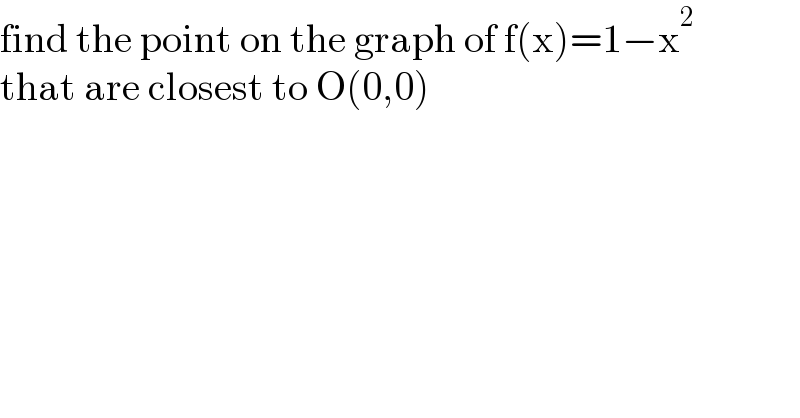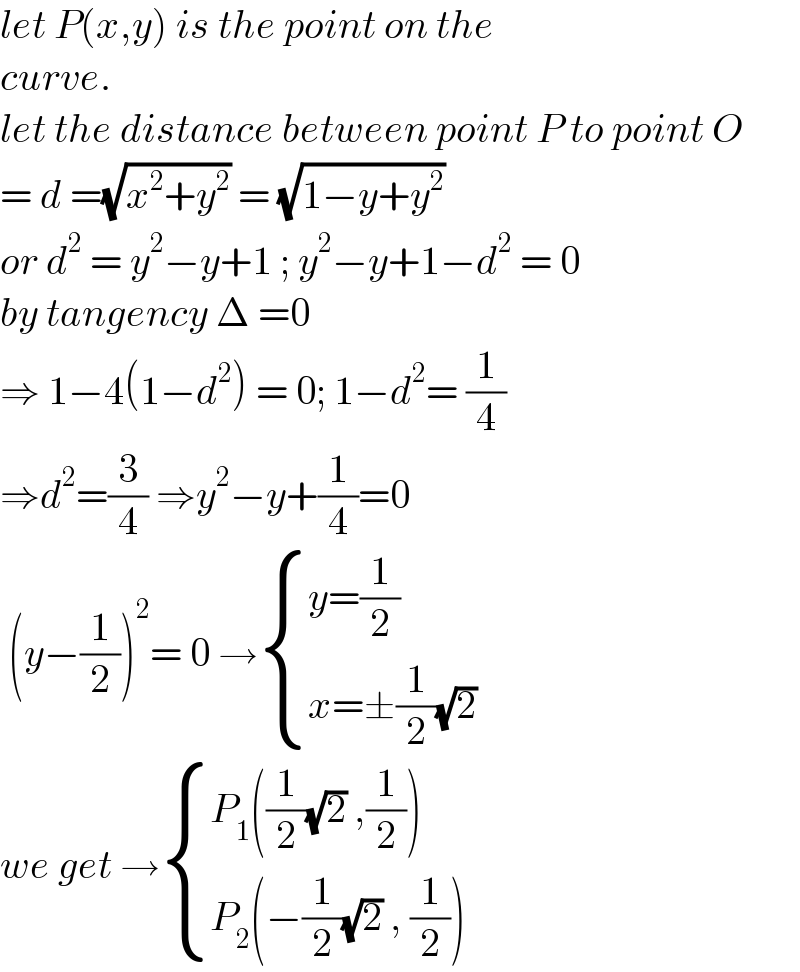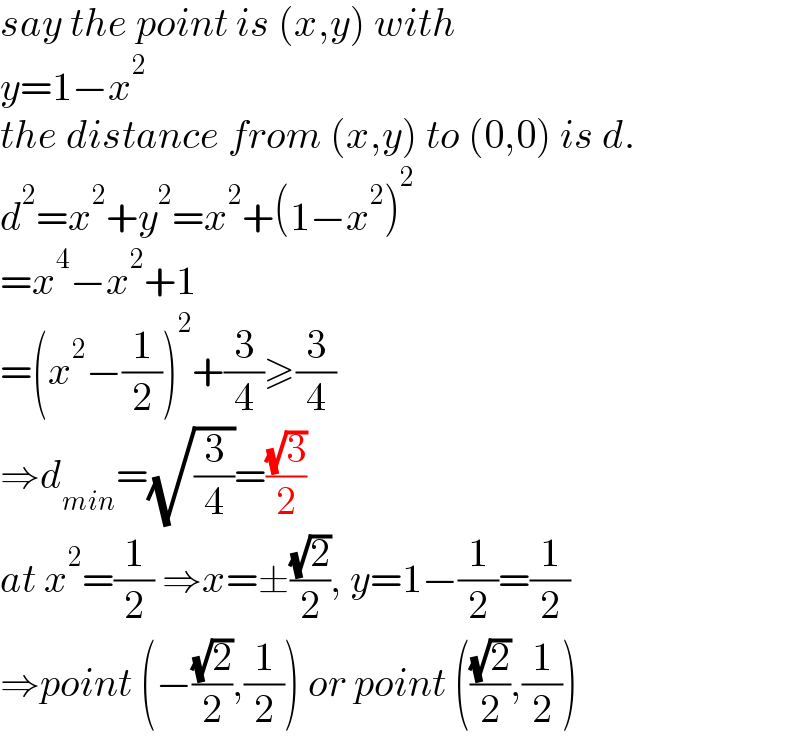Question Number 131188 by abdurehime last updated on 02/Feb/21

$$\mathrm{find}\:\mathrm{the}\:\mathrm{point}\:\mathrm{on}\:\mathrm{the}\:\mathrm{graph}\:\mathrm{of}\:\mathrm{f}\left(\mathrm{x}\right)=\mathrm{1}−\mathrm{x}^{\mathrm{2}} \\ $$$$\mathrm{that}\:\mathrm{are}\:\mathrm{closest}\:\mathrm{to}\:\mathrm{O}\left(\mathrm{0},\mathrm{0}\right) \\ $$
Answered by john_santu last updated on 02/Feb/21

$${let}\:{P}\left({x},{y}\right)\:{is}\:{the}\:{point}\:{on}\:{the} \\ $$$${curve}.\: \\ $$$${let}\:{the}\:{distance}\:{between}\:{point}\:{P}\:{to}\:{point}\:{O} \\ $$$$=\:{d}\:=\sqrt{{x}^{\mathrm{2}} +{y}^{\mathrm{2}} }\:=\:\sqrt{\mathrm{1}−{y}+{y}^{\mathrm{2}} } \\ $$$${or}\:{d}^{\mathrm{2}} \:=\:{y}^{\mathrm{2}} −{y}+\mathrm{1}\:;\:{y}^{\mathrm{2}} −{y}+\mathrm{1}−{d}^{\mathrm{2}} \:=\:\mathrm{0} \\ $$$${by}\:{tangency}\:\Delta\:=\mathrm{0}\: \\ $$$$\Rightarrow\:\mathrm{1}−\mathrm{4}\left(\mathrm{1}−{d}^{\mathrm{2}} \right)\:=\:\mathrm{0};\:\mathrm{1}−{d}^{\mathrm{2}} =\:\frac{\mathrm{1}}{\mathrm{4}} \\ $$$$\Rightarrow{d}^{\mathrm{2}} =\frac{\mathrm{3}}{\mathrm{4}}\:\Rightarrow{y}^{\mathrm{2}} −{y}+\frac{\mathrm{1}}{\mathrm{4}}=\mathrm{0} \\ $$$$\:\left({y}−\frac{\mathrm{1}}{\mathrm{2}}\right)^{\mathrm{2}} =\:\mathrm{0}\:\rightarrow\begin{cases}{{y}=\frac{\mathrm{1}}{\mathrm{2}}}\\{{x}=\pm\frac{\mathrm{1}}{\mathrm{2}}\sqrt{\mathrm{2}}}\end{cases} \\ $$$${we}\:{get}\:\rightarrow\begin{cases}{{P}_{\mathrm{1}} \left(\frac{\mathrm{1}}{\mathrm{2}}\sqrt{\mathrm{2}}\:,\frac{\mathrm{1}}{\mathrm{2}}\right)}\\{{P}_{\mathrm{2}} \left(−\frac{\mathrm{1}}{\mathrm{2}}\sqrt{\mathrm{2}}\:,\:\frac{\mathrm{1}}{\mathrm{2}}\right)}\end{cases} \\ $$
Commented by abdurehime last updated on 02/Feb/21

$$\mathrm{i}\:\mathrm{satisfied}\:\mathrm{100\%}\:\mathrm{allh}\:\mathrm{bless}\:\mathrm{you} \\ $$
Answered by mr W last updated on 02/Feb/21

$${say}\:{the}\:{point}\:{is}\:\left({x},{y}\right)\:{with} \\ $$$${y}=\mathrm{1}−{x}^{\mathrm{2}} \\ $$$${the}\:{distance}\:{from}\:\left({x},{y}\right)\:{to}\:\left(\mathrm{0},\mathrm{0}\right)\:{is}\:{d}. \\ $$$${d}^{\mathrm{2}} ={x}^{\mathrm{2}} +{y}^{\mathrm{2}} ={x}^{\mathrm{2}} +\left(\mathrm{1}−{x}^{\mathrm{2}} \right)^{\mathrm{2}} \\ $$$$={x}^{\mathrm{4}} −{x}^{\mathrm{2}} +\mathrm{1} \\ $$$$=\left({x}^{\mathrm{2}} −\frac{\mathrm{1}}{\mathrm{2}}\right)^{\mathrm{2}} +\frac{\mathrm{3}}{\mathrm{4}}\geqslant\frac{\mathrm{3}}{\mathrm{4}} \\ $$$$\Rightarrow{d}_{{min}} =\sqrt{\frac{\mathrm{3}}{\mathrm{4}}}=\frac{\sqrt{\mathrm{3}}}{\mathrm{2}} \\ $$$${at}\:{x}^{\mathrm{2}} =\frac{\mathrm{1}}{\mathrm{2}}\:\Rightarrow{x}=\pm\frac{\sqrt{\mathrm{2}}}{\mathrm{2}},\:{y}=\mathrm{1}−\frac{\mathrm{1}}{\mathrm{2}}=\frac{\mathrm{1}}{\mathrm{2}} \\ $$$$\Rightarrow{point}\:\left(−\frac{\sqrt{\mathrm{2}}}{\mathrm{2}},\frac{\mathrm{1}}{\mathrm{2}}\right)\:{or}\:{point}\:\left(\frac{\sqrt{\mathrm{2}}}{\mathrm{2}},\frac{\mathrm{1}}{\mathrm{2}}\right) \\ $$
